Table of Contents
We often wonder how sound travels to our ears. The human body has five different sense organs: eyes for sight, nose for smell, tongue for taste, skin for touch, and ears for hearing. The ear plays a crucial role in detecting sound. It captures sound waves from the environment, allowing us to recognize different sounds, such as music, voices, and nature. This ability helps us understand speech, enjoy music, and notice sounds around us, making the ear essential for communication and experiencing the world. For more information regarding the Human ear students are advised to go through the complete article below.
Human Ear
The Human Ear is a very special part of our body that allows us to hear and identify different sounds. It has three main parts: The outer ear, the middle ear, and the inner ear. Out of which the outer ear is responsible for collecting sound waves that travel down a canal to reach the middle ear. In the middle ear, tiny bones called the hammer, anvil, and stirrup make the sound louder. The inner ear converts these sounds into signals that travel to the brain, helping us understand what we hear. Additionally, our ears help us maintain balance, so we can stand and walk without falling. It’s important to take care of our ears to keep our hearing and valance healthy.
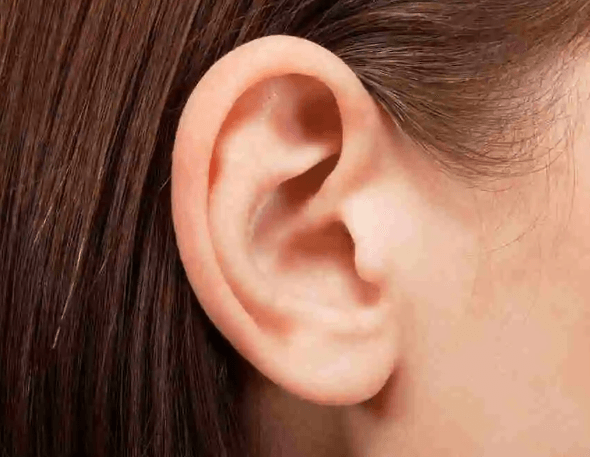
Structure of Human Ear
The ear is a complex structure that helps us hear and maintain balance. It consists of three main sections that work together to process sound. The outer section captures sound waves and directs them inward. The middle section amplifies these sound waves, while the inner section converts them into signals for the brain. Additionally, the inner ear plays a crucial role in balance. Together, these components allow us to experience sound and maintain our stability.
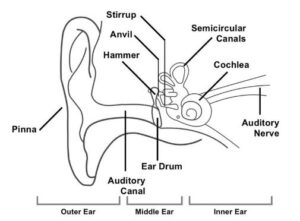
Parts of Human Ear
The human ear has three main parts: the outer ear, middle ear, and inner ear. The outer ear includes the part we see, called the pinna, which collects sound waves. The middle ear has tiny bones that help amplify these sounds. The inner ear contains the cochlea, a spiral-shaped organ filled with fluid that helps us hear by converting sound waves into signals for the brain. Together, these parts work to let us hear different sounds around us.
| Parts of Human Ear | ||
| Parts | Description | Function |
| Outer Ear | The outer ear comprises the pinna and ear canal. | Collects sound waves and directs them into the ear canal. |
| Middle Ear | The middle ear contains the eardrum and ossicles [malleus, incus, and stapes]. | Transmits sound vibrations from the eardrum to the inner ear. |
| Inner Ear | The inner ear contains the cochlea and vestibular system. | Converts sound vibrations into electrical signals for the brain and it also helps maintain balance. |
Outer Ear
The outer ear is that part of the ear which we can see. It includes the ear flap, called the pinna, which helps catch sounds from the air. The outer ear also has a tube called the ear canal that leads to the eardrum. Sounds travel through the air and enter the ear canal, making the eardrum vibrate. This vibration is the first step in how we hear. The outer ear protects the inner parts of the ear from dirt and water. It helps us hear sounds better by directing them into the ear, allowing us to enjoy music, voices, and other noises.
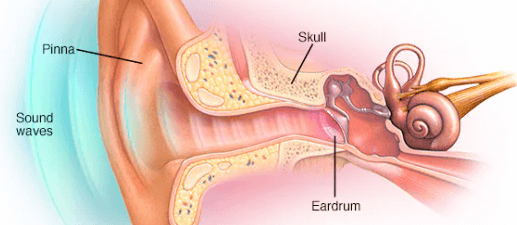
Parts of the Outer Ear
| Parts of the Outer Ear | |
| Parts | Description |
| Pinna (Auricle) | The visible part of the ear helps to collect sound waves and direct them into the ear canal. |
| Ear Canal (External Auditory Canal) | A tubular structure that transmits sound waves from the pinna to the eardrum. |
| Eardrum (Tympanic Membrane) | A thin membrane that vibrates in response to sound waves; separates the outer ear from the middle ear. |
| Earwax (Cerumen) | A waxy substance produced in the ear canal that helps to trap dirt and debris, protecting the ear canal and eardrum. |
Middle Ear
The middle ear is a small space inside your ear, located between the eardrum and the inner ear. It has three tiny bones called the hammer, anvil, and stirrup. When sound hits the eardrum, these bones move and pass the sound vibrations to the inner ear. The middle ear also has a tube called the Eustachian tube, which helps balance air pressure on both sides of the eardrum. This is important for hearing clearly and for keeping the ear healthy. The middle ear’s main job is to make sound vibrations stronger so they can be sent to the inner ear.
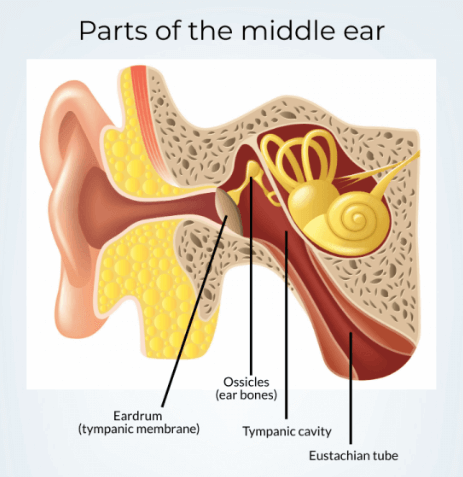
Parts of the Middle Ear
| Parts of the Middle Ear | |
| Parts | Description |
| Tympanic Membrane | Also known as the eardrum, it vibrates in response to sound waves, converting them into mechanical energy. |
| Ossicles | A chain of three tiny bones that amplify sound vibrations:
|
| Eustachian Tube | A tube that connects the middle ear to the throat, helping to equalize air pressure on both sides of the tympanic membrane. |
| Muscles | Two small muscles (tensor tympani and stapedius) that help protect the inner ear from loud sounds by dampening the movement of the ossicles. |
Inner Ear
The inner ear is the deepest part of the ear and is responsible for hearing and balance. It contains the cochlea, a spiral-shaped organ filled with fluid and tiny hair cells. When sound vibrations reach the cochlea, the fluid moves and the hair cells send signals to the brain, allowing us to hear. The inner ear also has the vestibular system, which helps us keep our balance. This system senses the position of our head and helps us stay steady when we move. The inner ear has two main parts Bony labyrinth and membraneous labyrinth.
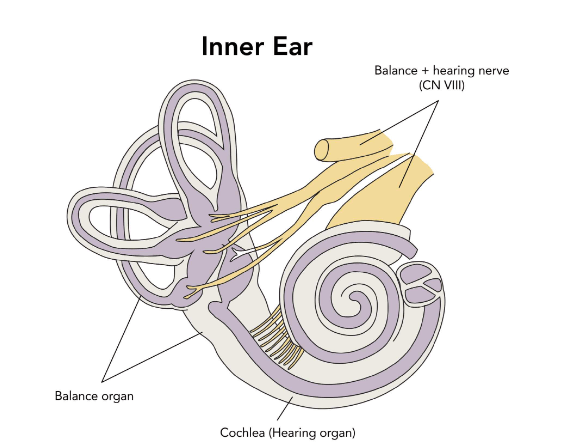
Parts of the Inner Ear
The inner part of the ear consists mainly of two different parts namely: the Bony Labyrinth and the Membranous Labyrinth.
Bony labyrinth
The rigid, outer structure of the inner ear is made of dense bone. It consists of three main sections:
- Cochlea: A spiral-shaped organ responsible for hearing.
- Vestibule: The central part that contains structures for balance.
- Semicircular Canals: Three looped structures that also play a role in balance and spatial orientation.
Membranous labyrinth
Membranous Labyrinth A flexible, fluid-filled system of sacs and ducts located within the bony labyrinth. It includes:
- Cochlear Duct: The part of the cochlea responsible for hearing.
- Utricle and Saccule: Structures within the vestibule that detect linear acceleration and head position.
- Semicircular Ducts: Three ducts within the semicircular canals that detect rotational movements of the head.
Functions of Human Ear
The human ear serves several important functions, primarily related to hearing and balance. Overall, the ear is vital for communication, safety, and interaction with the environment. Here are the key functions of the ear:
- Hearing: The primary function of the ear is to detect sound waves. The ear converts these sound waves into electrical signals that the brain interprets as sound.
- Balance: The inner ear also plays a crucial role in maintaining balance and spatial orientation. The vestibular system, which includes the semicircular canals, detects changes in head position and motion. This information helps the body maintain balance and coordinate movements.
- Protection: The ear has mechanisms to protect itself from loud noises. The muscles in the middle ear can contract to reduce the transmission of sound vibrations to the inner ear, helping to prevent damage.
- Sound Localization: The ear helps determine the direction and distance of sounds. The brain uses the differences in the time it takes for sounds to reach each ear and the differences in sound intensity to locate the source of a sound.
- Filtering Sounds: The ear can filter out background noise to focus on specific sounds, such as a conversation in a crowded room. This function is essential for communication and understanding in noisy environments.








 50 Vegetables Name for Kids in English a...
50 Vegetables Name for Kids in English a...
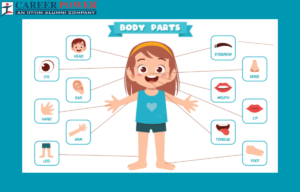 Body Parts Name, All 50 Body Parts Name ...
Body Parts Name, All 50 Body Parts Name ...
 Flowers Names in English and Hindi, List...
Flowers Names in English and Hindi, List...